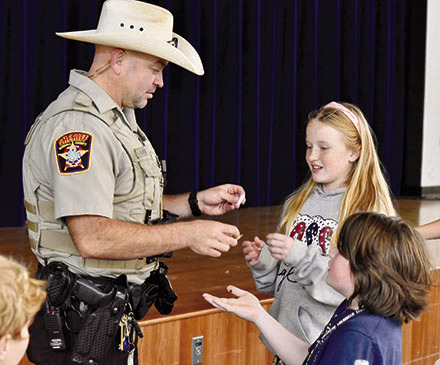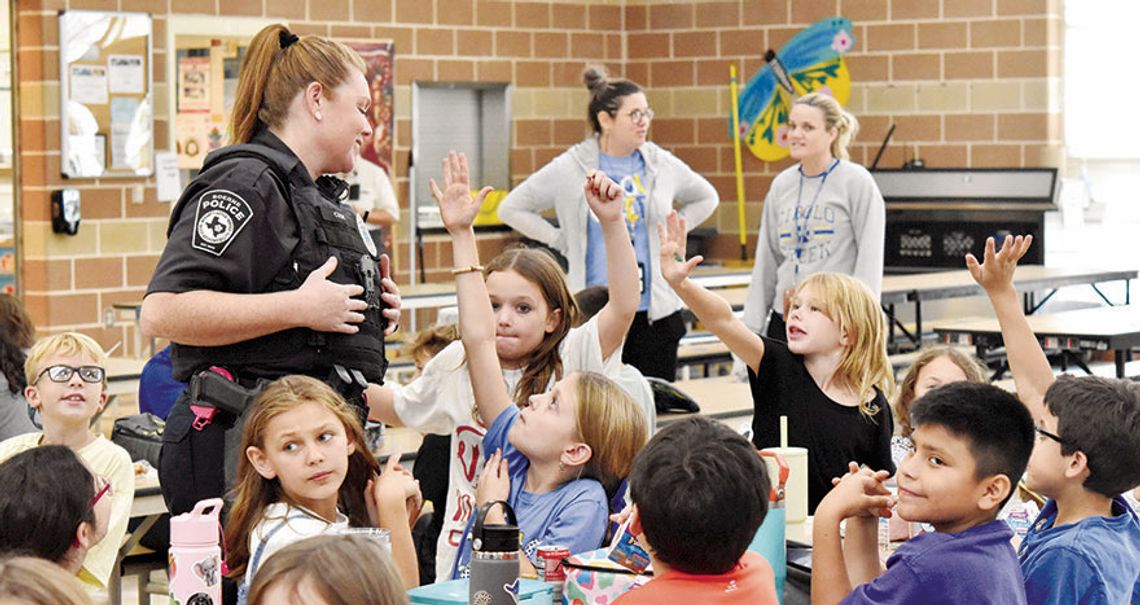How school resource officers build connection at school
If you’re curious about witnessing what celebrity status looks like, simply follow a uniformed school resource officer (SRO) into a crowded school cafeteria. Prepare to hear shouts of excitement that rival that of a Taylor Swift concert.
Officer Ryan Cook, SRO at Cibolo Creek Elementary, knows that walking into third-grade lunch means a lot of high-fives and hugs with students.
Cook knows that relationship building is key to her success working at the school. What makes giving out a high-five to a student just as important as writing a police report?
“To bridge the gap between the uniform and the student, because a lot of times we look intimidating,” she said.
Elementary kids may have little to no experience with law enforcement, she said, so one of her roles is to lay the groundwork for positive relationships between police officers and students.
“It helps them get comfortable (with) me. If they have a problem, I try really hard to make sure they know they can run to me and not away from me, not to be afraid of me, and I try to convey that to the parents also,” she said.
As students transition to middle and high school — and as problems naturally increase in complexity — the role of the SRO becomes more layered. Officer Roger Fuentes, Boerne High School SRO, knows that he also serves as an “unofficial counselor” for students.
“Kids here are teenagers going through a rough time in their life. Sometimes they just need people to talk to,” Fuentes said. “I’m just that outer third-party person that they can talk to and feel comfortable with. I can give them advice and help them get through it and just listen to them.”
And when their SRO has to be off campus, the students notice. “Whenever we had a different police officer it was never the same. Because we didn’t really know them,” said Destiny Galloway, a Boerne High junior. “We have a relationship with Fuentes.”
For Fuentes, he knows that building trust with students is a key component to changing behavior.
“It changes their demeanor, so they come to school not wanting to be so rebellious or fight. People here truly want to help them. They actually want to come to school and learn,” he said.
Deputy Jared Moore, from the Kendall County Sheriff’s Office and SRO at Voss Middle School, knows the middle school years are a critical time in building trust through positive interactions with students.
“I know day to day, in talking with kids; you get to know them, they get to know you,” Moore said. “They know that on your off time you have a family, you have kids, you have pets and you have a social life. You’re a real person.”
Just like Cook, Moore finds himself elevated to celebrity status when walking into the school cafeteria. He challenges students with a “question of the day” during lunch periods, rewarding correct answers with high-fives and fist bumps. “They come up to me wanting just to give a high-five,” Moore said.
In the delicate art of relationship building with middle school students, it’s the little details that can make a big difference in making a student feel seen and heard.
“It’s knowing those personal things about the kids, their birthday, remembering if they are hockey players or play archery or into a club or sport,” he said.
For these officers, who interact with hundreds of students every day, good communication skills and patience are essential.
“SROs are required to interact with young students, parents and staff and need to know how to adapt or alter their communication styles based on who their audience is. So communication skills are very important,” said Boerne Chief of Police Steve Perez.
Some days the officers sit with a crying student, upset about a bad test grade. Some days they serve as attentive listeners for a student going through a break-up. Some days it’s the comforting task of reading a book to a captivated class of kindergarten students.
When the final high-five is given at the end of the day, these real-life campus “celebrities” know that the spotlight is not on them, but on their connection with the students.








Comment
Comments